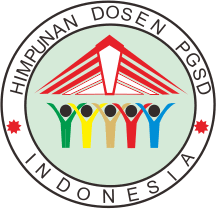Penerapan media visual dalam pembelajaran IPAS untuk meningkatkan hasil belajar peserta didik sekolah dasar
Abstract
Keywords
Full Text:
PDFReferences
OECD, “PISA 2022 results: The state of learning and equity in education,” OECD Publishing, 2023.
OECD, “Results (Volume I): What students know and can do,” Organization for Economic Cooperation and Development (OECD): Paris, France, 2019.
R. Indonesia, “Peraturan Pemerintah Nomor 57 Tahun 2021 tentang Standar Nasional Pendidikan,” Lembaran Negara Republik Indonesia Tahun, 2021.
J. W. Santrock, Educational psychology. McGraw-Hill, 2011.
A. Sugianto, “Kuesioner Gaya Belajar Siswa,” 2021. Accessed: Jun. 02, 2025. [Online]. Available: https://repo-dosen.ulm.ac.id/handle/123456789/26041
K. B. McDermott and C. L. Zerr, “Individual Differences in Learning Efficiency,” Curr Dir Psychol Sci, vol. 28, no. 6, pp. 607–613, Dec. 2019, doi: 10.1177/0963721419869005.
J. Cuevas and B. L. Dawson, “A test of two alternative cognitive processing models: Learning styles and dual coding,” Theory and Research in Education, vol. 16, no. 1, pp. 40–64, Mar. 2018, doi: 10.1177/1477878517731450.
D. H. . Schunk, Learning theories : an educational perspective. Pearson, 2012.
F. Yuanta, “Pengembangan Media Video Pembelajaran Ilmu Pengetahuan Sosial pada Siswa Sekolah Dasar,” Trapsila: Jurnal Pendidikan Dasar, vol. 1, no. 2, pp. 91–100, Dec. 2019, doi: http://dx.doi.org/10.30742/tpd.v1i02.816.
D. M. Prabowo and D. Wulandari, “Pengembangan Media Diorama 3 Dimensi dalam Pembelajaran IPA Materi Ekosistem Kelas V,” Joyful Learning Journal, vol. 6, no. 4, 2017, [Online]. Available: http://journal.unnes.ac.id/sju/index.php/jlj
K. dan A. P. Badan Standar, Panduan pembelajaran dan asesmen. Kementerian Pendidikan, Kebudayaan, Riset, dan Teknologi., 2022.
W. Kusuma and D. Dwitagama, Mengenal penelitian tindakan kelas , 2nd ed. Jakarta: Indeks, 2022.
W. Sanjaya, Penelitian pendidikan: Jenis, metode, dan prosedur. 2015.
J. W. Creswell and J. D. Creswell, Research Design : Qualitative, Quantitative, and Mixed Methods Approaches, 6th ed. SAGE Publications, Inc., 2023.
S. E. . Smaldino, D. L. . Lowther, Clif. Mims, and J. D. . Russell, Instructional technology and media for learning. Pearson Education, Inc., 2019.
A. Sulastri, “Peningkatan Hasil Belajar Melalui Media Visual pada Mata Pelajaran IPA Siswa Kelas V Sekolah Dasar,” Indonesian Research Journal on Education, vol. 2, no. 2, pp. 812–822, 2022.
W. N. Aeni, Y. Darusman, and H. H. Mahendra, “Penggunaan Media Pembelajaran Dengan Benda Konkret Untuk Meningkatan Hasil Belajar Siswa Pada Mata Pelajaran Matematika,” in SHES: Journal of Sharia Economic and Education Studies, 2019, pp. 148–154. [Online]. Available: https://jurnal.uns.ac.id/shes
J. W. Santrock, Educational Psychology, 8th ed. MCGRAW-HILL EDUCATION, 2024.
A. M. Pohan, Y. Sahanaya, M. B. Lase, F. Y. Siregar, I. Wijaya, and J. Chen, “Peran Media Audio Visual Terhadap Hasil Belajar Bahasa Mandarin Siswa Kelas 5 SD Global Prima Medan,” Jurnal Basataka (JBT), vol. 7, no. 1, pp. 321–326, 2024.
Refbacks
- There are currently no refbacks.


